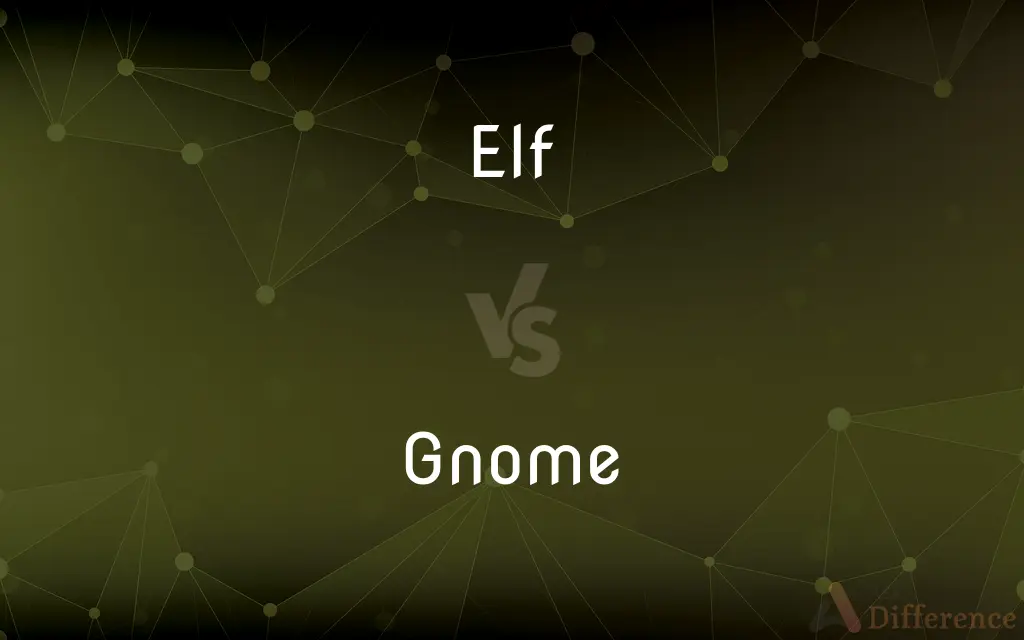Elf vs. Gnome — What's the Difference?
Edited by Tayyaba Rehman — By Fiza Rafique — Updated on November 2, 2023
Elves are mythical beings with magical powers and pointed ears, often depicted as tall and fair, while gnomes are mythological creatures, typically portrayed as small, earth-dwelling, and elderly with beards.

Difference Between Elf and Gnome
Table of Contents
ADVERTISEMENT
Key Differences
Elves, within various mythologies and fantasy literature, are often depicted as tall, slender, and aesthetically beautiful with pointed ears and a natural affinity for magic. They are typically considered immortal or long-lived, and their narratives are rich in folklore, spanning from Norse mythology to modern fantasy. Gnomes, on the other hand, are commonly described as small, stout, and elderly-looking, often with a beard and a pointy hat, representing a connection to the earth, with many lore suggesting they live underground or within the forest and guard treasures.
In cultural representation, elves have been popularized in modern times by works like J.R.R. Tolkien's Middle-earth legendarium, where they are portrayed as an ancient and wise race that is in harmony with nature. Gnomes, while also featured in literature, are more commonly associated with garden statues and Christmas folklore, representing a more whimsical and earthy spirit that tends to plants and minerals. Both elves and gnomes are used extensively in various genres of fantasy and are recognized characters in role-playing games.
The term "elf" has its roots in Germanic mythology where they were considered as supernatural beings with powers to affect human health and fortune. Elves have been integral to many fairy tales and fantasy stories, often embodying the higher ideals of beauty and grace. Gnomes, traditionally found in Renaissance magic and alchemy, were believed to be creatures that could move through the earth as easily as humans walk on it. They were said to be guardians of secret knowledge, with a keen interest in mining and precious gems.
Elves have evolved in the public imagination, thanks to their portrayal in various media, as guardians of ancient forests or otherworldly guides. Their demeanor is often depicted as serious and their roles significant, engaging in the epic and the profound. Gnomes have taken a more lighthearted route, often being the subject of garden ornaments or children's tales. They are perceived as benign but mischievous, with a love for practical jokes and a closer affinity to the everyday magic of the hearth and home.
Both elves and gnomes are a testament to humanity's love for myth and the fantastic. While elves are often portrayed as otherworldly and almost divine, gnomes are considered as earth-bound and simple. Despite their differences, both have a place in the modern fantasy genre and continue to enchant audiences with their distinctive characteristics and mystical abilities. Their legacies continue to grow as each generation reinvents these creatures for new stories and tales.
ADVERTISEMENT
Comparison Chart
Size
Typically tall and slender
Small and stout
Origin of Myth
Germanic myths
Renaissance magic and alchemy
Habitat
Forests, otherworldly realms
Underground, gardens
Appearance
Pointed ears, fair, often youthful
Bearded, elderly, wearing pointy hats
Role in Culture
Warriors, guides, connected to magic
Earth spirits, guardians of treasures
Representation
Serious, graceful
Whimsical, earthy
Compare with Definitions
Elf
Elves are featured in Christmas lore as Santa's helpers, making toys in his workshop.
Children around the world await the gifts crafted by Santa's merry elves.
Gnome
A gnome can also be a term for a small person or a person considered endearing in their gruffness.
Grandpa's grouchy ways and short stature earned him the nickname 'the family gnome'.
Elf
An elf is a mythical creature of Germanic folklore with magical powers and an ethereal appearance.
The elf glided silently through the ancient forest.
Gnome
In children’s stories, gnomes are often portrayed as magical creatures that get into mischief.
The gnome in the story caused playful chaos with his enchantments.
Elf
In literature, an elf is often a tall, pointy-eared being with a natural talent for archery and magic.
Legolas, the elf from The Lord of the Rings, was renowned for his sharpshooting.
Gnome
A gnome is a mythical being that is earthbound, small in stature, and associated with guarding treasure.
The gnome stood watch over the hidden underground jewels.
Elf
In role-playing games, an elf is a character race known for agility and magic abilities.
She chose an elf character to take advantage of its stealth skills.
Gnome
Gnomes are depicted in fantasy literature as wise beings with a deep knowledge of the earth.
The gnome shared ancient secrets about the healing herbs.
Elf
"Elf" can refer to a person who is remarkably delicate or small, often in a charming manner.
The little girl was often called an elf due to her playful and mischievous demeanor.
Gnome
A gnome is a mythological creature and diminutive spirit in Renaissance magic and alchemy, first introduced by Paracelsus in the 16th century and later adopted by more recent authors including those of modern fantasy literature. Its characteristics have been reinterpreted to suit the needs of various story tellers, but it is typically said to be a small humanoid that lives underground.Diminutive statues of gnomes introduced as lawn ornaments during the 19th century grew in popularity during the 20th century and came to be known as garden gnomes.
Elf
An elf (plural: elves) is a type of humanoid supernatural being in Germanic mythology and folklore (especially North Germanic mythology and folklore). In medieval Germanic-speaking cultures, elves generally seem to have been thought of as beings with magical powers and supernatural beauty, ambivalent towards everyday people and capable of either helping or hindering them.
Gnome
One of a fabled race of dwarflike creatures who live underground and guard treasure hoards.
Elf
A mythical creature in human form but usually smaller, often considered mischievous.
Gnome
In the occult philosophy of Paracelsus, a being that has earth as its element.
Elf
A lively, mischievous child.
Gnome
A pithy saying that expresses a general truth or fundamental principle; an aphorism.
Elf
A usually sprightly or mischievous or sometimes spiteful person.
Gnome
A brief reflection or maxim; a pithy saying.
Elf
(Norse mythology) A luminous spirit presiding over nature and fertility and dwelling in the world of Álfheim (Elfland). Compare angel, nymph, fairy.
Gnome
An elemental (spirit or corporeal creature associated with a classical element) associated with earth.
Elf
Any from a race of mythical, supernatural beings resembling but seen as distinct from human beings. They are usually delicate-featured and skilled in magic or spellcrafting; sometimes depicted as clashing with dwarves, especially in modern fantasy literature.
Gnome
One of a race of imaginary human-like beings, usually depicted as short and typically bearded males, who inhabit the inner parts of the earth and act as guardians of mines, mineral treasure, etc.; in modern fantasy literature and games, when distinguished from dwarves, gnomes are usually even smaller than dwarves and more focussed on engineering than mining.
Elf
(fantasy) Any of the magical, typically forest-guarding races bearing some similarities to the Norse álfar (through Tolkien's Eldar).
Gnome
A person of small stature or misshapen features, or of strange appearance.
Elf
A very diminutive person; a dwarf.
Gnome
The northern pygmy owl, Glaucidium gnoma, a small owl of the western United States.
Elf
(South Africa) The bluefish (Pomatomus saltatrix).
Gnome
A small statue of a dwarf-like character, often bearded, placed in a garden.
Elf
To twist into elflocks (of hair); to mat.
Gnome
An upper atmospheric optical phenomenon associated with thunderstorms, a compact blue starter.
Elf
An imaginary supernatural being, commonly a little sprite, much like a fairy; a mythological diminutive spirit, supposed to haunt hills and wild places, and generally represented as delighting in mischievous tricks.
Every elf, and fairy sprite,Hop as light as bird from brier.
Gnome
A banker, especially a secretive international one.
The gnomes of Zurich
Elf
A very diminutive person; a dwarf.
Gnome
An imaginary being, supposed by the Rosicrucians to inhabit the inner parts of the earth, and to be the guardian of mines, quarries, etc.
Elf
To entangle mischievously, as an elf might do.
Elf all my hair in knots.
Gnome
A dwarf; a goblin; a person of small stature or misshapen features, or of strange appearance.
Elf
(folklore) fairies that are somewhat mischievous
Gnome
A small owl (Glaucidium gnoma) of the Western United States.
Elf
Below 3 kilohertz
Gnome
A brief reflection or maxim.
Gnome
A legendary creature resembling a tiny old man; lives in the depths of the earth and guards buried treasure
Gnome
A short pithy saying expressing a general truth
Gnome
In garden decor, a gnome is a small statue representing a bearded creature with a pointed hat.
Their garden was adorned with colorful gnome statues.
Common Curiosities
Are gnomes always depicted as smaller than elves?
Yes, gnomes are typically shown as smaller, whereas elves are often depicted as human-sized or taller.
Do elves and gnomes have similar powers?
Elves are traditionally associated with magic and nature, while gnomes are often connected to the earth and elemental magic.
Can elves and gnomes both be good and evil?
Yes, both elves and gnomes can be depicted with a range of moral alignments, from benevolent to malevolent.
Do elves and gnomes both have a connection to Christmas?
Elves are commonly linked to Christmas as Santa’s helpers, while gnomes do not traditionally have a significant role in Christmas lore.
In folklore, do elves interact with humans more than gnomes do?
Elves are often depicted as interacting with humans, either helping or hindering them, while gnomes are more reclusive.
Are garden gnomes based on the mythological creature?
Yes, garden gnome statues are whimsical representations of the mythological earth-dwelling creature.
Are elves and gnomes part of the same mythology?
Elves originate from Germanic mythology, while gnomes come from Renaissance lore, so they are from different mythological traditions.
Do elves appear in high fantasy genres more often than gnomes?
Elves are more common in high fantasy due to their ethereal and majestic qualities, whereas gnomes are often seen in more earthy, whimsical contexts.
Have gnomes appeared in popular media as often as elves?
Elves tend to be more prevalent in popular media, especially in fantasy films and literature.
Are there different types of elves and gnomes in mythology?
Yes, various cultures have different interpretations of elves and gnomes, each with unique characteristics.
Are there famous literary works featuring gnomes similar to Tolkien's elves?
While gnomes appear in various fantasy works, there isn't a singularly renowned gnome equivalent to Tolkien's elves.
Is there a difference in how elves and gnomes are used in modern gaming?
In gaming, elves are often playable characters with specific abilities, while gnomes may appear as NPCs or less common character choices.
Are elf and gnome characters popular in children’s fairy tales?
Both creatures are staples in fairy tales, with elves often playing more prominent and varied roles than gnomes.
Are gnomes considered nature spirits like some elves?
Gnomes are often considered nature spirits, particularly of the earth, similar to how some elves are viewed as spirits of the forest.
Can the term "elf" be derogatory when referring to a person?
Depending on context, calling someone an "elf" could be seen as a comment on their size or appearance and could be taken negatively.
Share Your Discovery

Previous Comparison
Allocentrism vs. Idiocentric
Next Comparison
Cognac vs. GrappaAuthor Spotlight
Written by
Fiza RafiqueFiza Rafique is a skilled content writer at AskDifference.com, where she meticulously refines and enhances written pieces. Drawing from her vast editorial expertise, Fiza ensures clarity, accuracy, and precision in every article. Passionate about language, she continually seeks to elevate the quality of content for readers worldwide.
Edited by
Tayyaba RehmanTayyaba Rehman is a distinguished writer, currently serving as a primary contributor to askdifference.com. As a researcher in semantics and etymology, Tayyaba's passion for the complexity of languages and their distinctions has found a perfect home on the platform. Tayyaba delves into the intricacies of language, distinguishing between commonly confused words and phrases, thereby providing clarity for readers worldwide.















































